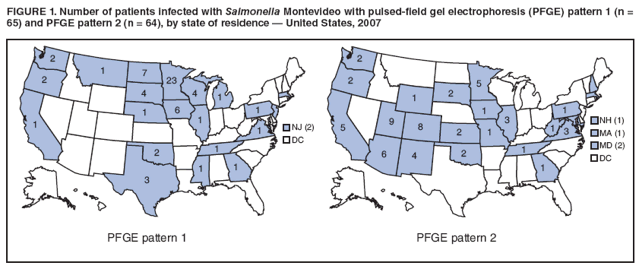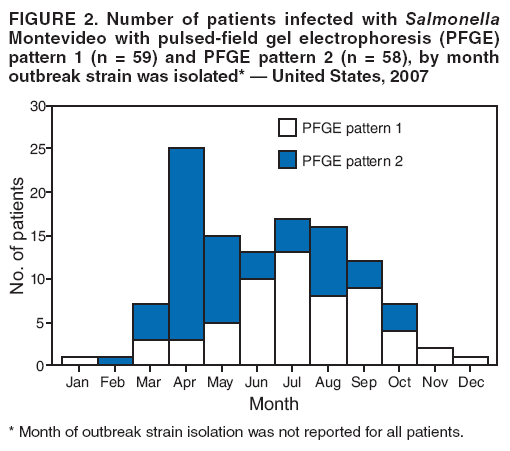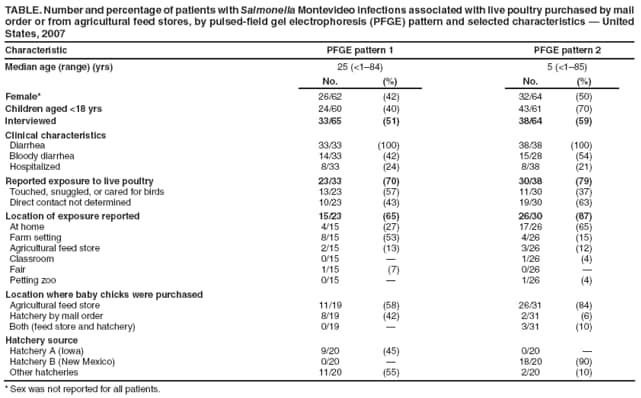 |
|
|
|
|
|
|
| ||||||||||
|
|
|
|
|
|
|
||||
| ||||||||||
|
|
|
|
|
Persons using assistive technology might not be able to fully access information in this file. For assistance, please send e-mail to: mmwrq@cdc.gov. Type 508 Accommodation and the title of the report in the subject line of e-mail. Multistate Outbreaks of Salmonella Infections Associated with Live Poultry --- United States, 2007During June 2007, the Minnesota Department of Health (MDH) Public Health Laboratory examined specimens from two ill persons and identified Salmonella Montevideo isolates with the same pulsed-field gel electrophoresis pattern (PFGE pattern 1). MDH officials interviewed the patients and determined that both had been exposed to chickens originating from the same Iowa hatchery (hatchery A). In September 2007, a cluster of seven additional infections with PFGE pattern 1 was identified in North Dakota; all seven patients had been exposed to baby chicks obtained from hatchery A. A subsequent nationwide investigation identified a total of 65 S. Montevideo isolates with PFGE pattern 1 during 2007 and a likely association with exposure to live poultry purchased at feed stores or by mail order from hatchery A or seven other hatcheries in four states. Meanwhile, throughout 2007, a separate outbreak was occurring that involved infections with a different S. Montevideo strain (PFGE pattern 2). A total of 64 of those isolates were identified in 23 states during 2007. Exposure to live poultry from a hatchery in New Mexico (hatchery B) and a hatchery in Ohio (hatchery C) was associated with those infections. This report describes two distinct and unrelated outbreaks, which demonstrate the ongoing risk for Salmonella infection from live poultry purchased from agricultural feed stores or directly from mail order hatcheries. The mail order hatchery industry is a source of bird-associated human pathogens, such as Salmonella, and comprehensive infection-control strategies are needed to prevent additional illnesses resulting from live poultry contact. Outbreak of S. Montevideo, PFGE pattern 1After the MDH Public Health Laboratory identified the initial two S. Montevideo isolates with the same PFGE pattern (PFGE pattern 1*) in June 2007, MDH officials interviewed the patients and determined that both had been exposed recently to live chickens originating from hatchery A. Chicken and chicken enclosure environmental samples collected at one patient's residence yielded S. Montevideo isolates with PFGE pattern 1. In September 2007, the North Dakota Department of Health (NDDOH) Public Health Laboratory identified seven additional S. Montevideo isolates with PFGE pattern 1. Three of the seven source patients were siblings, aged 1, 3, and 7 years. All three developed diarrhea, vomiting, and abdominal cramps. The children were hospitalized for 8--10 days. Blood specimens from two children yielded S. Montevideo with PFGE pattern 1. Environmental specimens collected from a bird enclosure at the siblings' residence also yielded S. Montevideo with PFGE pattern 1. Initial investigation revealed that the onset of symptoms occurred 2 days after the family received chicks from hatchery A via mail order. The parents of the children were unaware that contact with baby poultry put their children at risk for salmonellosis. Beginning in June 2007, CDC undertook a review of national PulseNet† data for 2007 to identify additional isolates with S. Montevideo with PFGE pattern 1. During April--September 2007, local and state health department investigators interviewed patients with S. Montevideo infection using a structured questionnaire to obtain clinical and exposure information (some interviews were conducted as part of routine follow-up investigations, before the identification of the outbreak). A total of 65 S. Montevideo isolates with PFGE pattern 1, including the two isolates from Minnesota and the seven from North Dakota (Figure 1) were identified nationwide. Forty-two percent of isolates were from females, and the median age of patients was 25 years (range: 2 months--84 years). Forty percent of patients were children aged <18 years. Health department investigators interviewed 33 (51%) of the 65 patients, of whom 33 (100%) reported diarrhea, 14 (42%) reported bloody diarrhea, and eight (24%) were hospitalized (Table). No deaths were reported. Twenty-three (70%) of the 33 interviewed patients reported exposure to live poultry during the 5 days before illness onset. Thirteen (57%) of these 23 touched, snuggled, or cared for birds; direct physical contact could not be determined for the other 10 patients reporting exposure.§ Location of exposure to live poultry was reported for 15 patients; four were exposed at home, eight on a farm, two in an agricultural feed store, and one at a fair. Purchase information was reported for 19 patients; 11 purchased birds from an agricultural feed store, and eight purchased by mail order. The hatchery source of the baby poultry was reported for 20 patients; nine reported poultry originating from hatchery A in Iowa, and 11 reported poultry from one of seven other hatcheries in four other states. Of 23 patients from Minnesota, 19 (83%) answered additional questions about the reasons they purchased baby chicks. Of these 19, nine (47%) reported that they purchased the birds to raise for meat and had contact with the birds when they were chicks and later when they were chickens. Investigation of hatchery A by the Iowa Department of Agriculture revealed multiple egg suppliers and outsourcing of hatching to smaller firms. No samples were collected from hatchery A during a visit by investigators. Education of hatchery personnel was conducted. In response to the infections in North Dakota, NDDOH, in collaboration with the North Dakota Board of Animal Health and Department of Agriculture, developed posters and flyers to be distributed and posted at agricultural feed stores, veterinary clinics, extension agent offices, auction markets, pet stores, and animal shelters.¶ The education materials were distributed, accompanied by a letter from the state epidemiologist and the state veterinarian explaining the risk of handling birds and how to prevent Salmonella infection. In addition, NDDOH sent a letter to school principals, pediatricians, family medicine practitioners, and infection-control practitioners, notifying them about the outbreak and the education materials. Similar initiatives were implemented by MDH. Outbreak of S. Montevideo, PFGE pattern 2S. Montevideo with PFGE pattern 2** was first identified in 2004, when reports of two such isolates were uploaded to PulseNet. Isolates with pattern 2 were detected during outbreaks of human Salmonella infections in 2005 and 2006, and were linked to contact with chicks and ducklings from hatchery B in New Mexico (1). During 2007, CDC continued to monitor isolates with pattern 2 reported to PulseNet. Local and state health department investigators interviewed patients with S. Montevideo PFGE pattern 2 infections using a structured questionnaire to obtain clinical and exposure information. By the end of 2007, 64 S. Montevideo PFGE pattern 2 isolates from 23 states had been identified (Figure 1). Isolates were reported from February through October (Figure 2). Thirty-two (50%) of the 64 patients were female; the median age of patients was 5 years (range: 3 months--85 years), and 70% were children aged <18 years. Interviews were conducted with 38 (59%) of the 64 patients. All 38 patients reported diarrhea, 15 (54%) of 28 reported bloody diarrhea, and eight (21%) of 38 were hospitalized. No deaths were reported. Thirty (79%) patients reported exposure to live poultry during the 5 days before illness onset. Eleven (37%) of the 30 touched, snuggled, or cared for birds; direct contact could not be determined for the other 19 patients reporting exposure. Location of exposure was reported for 26 patients; 17 (65%) were exposed at home, four (15%) on a farm, three (12%) in an agricultural feed store, one (4%) in a classroom, and one (4%) at a petting zoo. Purchase information was reported by 31 patients; 26 (84%) purchased from an agricultural feed stores, two (6%) purchased directly from a mail order hatchery, and three (10%) purchased birds both from an agricultural feed store and by mail order. The hatchery source of the baby poultry was reported for 20 patients; 18 (90%) reported poultry originating from hatchery B in New Mexico, and two (10%) reported poultry from hatchery C in Ohio. S. Montevideo with PFGE pattern 2 was isolated from environmental samples collected at hatchery B in October 2007. During 2007, in response to the reported human infections traced back to their facility, the operators of hatchery B implemented several on-farm measures in an attempt to eliminate S. Montevideo from their birds, including enhanced hygiene practices and use of an S. Montevideo pattern 2 serotype-specific vaccine in their flocks. Hatchery A has recently implemented some of the same measures at its facility. Reported by: E Hedican, MPH, K Smith, DVM, S Jawahir, MS, J Scheftel, DVM, Minnesota Dept of Health. K Kruger, R Birk, MS, JL Goplin, MS, North Dakota Dept of Health. A Garvey, DVM, Iowa Dept of Public Health; D Schmitt, DVM, Iowa Dept of Agriculture and Land Stewardship; DW Trampel, DVM, Iowa State Univ. CA Perry, MJ Sotir, PhD, FJ Angulo, DVM, Div of Foodborne Bacterial and Mycotic Diseases, National Center for Zoonotic, Vector-Borne, and Enteric Diseases; U Sharapov, MD, C Barton Behravesh, DVM, EIS officers, CDC. Editorial Note:Nontyphoidal salmonellosis is an important cause of human illnesses in the United States, resulting in an estimated 1.4 million infections and approximately 400 deaths annually (2). Poultry are a known reservoir of Salmonella, and transmission to humans after contact with live poultry is a well-recognized public health problem (3,4). Baby poultry, in particular chicks and ducklings, have been the source of several recent outbreaks of human Salmonella infections (1). This report documents two distinct and unrelated outbreaks of salmonellosis likely caused by exposure to live poultry purchased by mail order or from agricultural feed stores. Several hatcheries, including two implicated in the outbreaks described in this report, hatchery A in Iowa and hatchery B in New Mexico, have been linked to outbreaks repeatedly (1). The illnesses in the North Dakota siblings highlight the risk for severe disease from Salmonella infections, especially in young children. The two outbreaks had different features. Seventy percent of the infections in the outbreak with PFGE pattern 2 occurred in children and involved contact with baby poultry, and 62% of the infections occurred during the spring (Figure 2), similar to previously reported poultry-associated outbreaks (1,3--6). Many of the implicated birds were purchased as pets during the Easter holiday season. In contrast, in the outbreak with PFGE pattern 1, 60% of the infections occurred in adults, involved contact with older birds, and occurred later in the calendar year. A sizeable proportion of the pattern 1 birds likely were purchased for production of meat and eggs in backyard flocks. Hatcheries that sell live poultry to the public often sell the birds both directly to consumers via mail order and to agricultural feed stores. Specific distribution information (e.g., the proportion of baby chicks sold via mail order or through feed stores) for this industry is largely unavailable. In addition, certain hatcheries use a practice called drop shipping (when one hatchery is not able to fill a customer's order and a second hatchery is called upon to ship birds directly to the customer under the first hatchery's name). Customers might not realize that the actual source of the purchased birds was a different hatchery than the one where the original order was placed. Drop shipping occurs with minimal regulatory oversight or health certification, making assessment of the scope of distribution and size of population exposed difficult. Agricultural feed stores receive shipments of baby poultry from multiple hatcheries, making determination of the hatchery of origin for individual birds difficult. State regulations requiring customers to be informed about the health risks associated with poultry contact are voluntary, vary by state, and are not uniformly enforced (1). To prevent salmonellosis, persons handling poultry should be warned about the risks of contact with live poultry and should be educated about handwashing after contact with poultry or poultry environments. In addition, agricultural feed stores should provide handwashing facilities and information on salmonellosis to persons considering a live poultry purchase (7). Hatcheries and agricultural feed stores should provide their customers with written recommendations on ways to prevent transmission of Salmonella from birds to humans. Chicks and other live poultry should not be given as gifts to young children. Live poultry should be kept separate from areas where food and drinks are prepared or consumed. Children aged <5 years should not be allowed to handle baby chicks or other poultry. All surfaces that come into contact with live poultry (e.g., hands, floors, tables, rugs, shipment boxes, dust, and chicken enclosures) might be contaminated with Salmonella. All persons should wash their hands with soap and warm water for at least 20 seconds after touching live poultry or surfaces in contact with live poultry.†† Additional S. Montevideo infections with PFGE patterns 1 and 2 were reported in 2008. As of September 30, 2008, an additional 66 cases of pattern 1 infection and 11 cases of pattern 2 infection had been reported in the United States. These illnesses are currently under investigation by local, state, and federal public health agencies. CDC and state health departments continue to conduct enhanced surveillance for Salmonella infections associated with live poultry from mail order hatcheries and agricultural feed stores and are working with hatcheries and local, state, and federal partners to prevent illnesses related to live poultry exposure. Acknowledgments This report is based, in part, on contributions by T Gomez, DVM, and A Rhorer, Veterinary Svcs, Animal and Plant Health Inspection Svc, US Dept of Agriculture. References
* XbaI pattern JIXX01.0021. † PulseNet is the national molecular subtyping network for foodborne disease surveillance in the United States. § Live poultry contact was not defined for these 10 patients; therefore, the extent of any contact is unknown. However, two patients reported indirect contact with live birds. Before his illness, one patient reported consuming strawberries that had been picked from a farm with chickens on site. Another patient reported biking on a trail near a lake with geese and fowl and changing at least one bicycle tire that might have come into contact with bird feces on the trail. ¶ Available at http://www.ndhealth.gov/disease/salmonella/default.htm. ** XbaI pattern JIXX01.0049. †† Additional information about the risks associated with contact with live poultry is available at http://www.cdc.gov/healthypets/easter_chicks.htm. Figure 1  Return to top. Figure 2  Return to top. Table  Return to top.
All MMWR HTML versions of articles are electronic conversions from typeset documents. This conversion might result in character translation or format errors in the HTML version. Users are referred to the electronic PDF version (http://www.cdc.gov/mmwr) and/or the original MMWR paper copy for printable versions of official text, figures, and tables. An original paper copy of this issue can be obtained from the Superintendent of Documents, U.S. Government Printing Office (GPO), Washington, DC 20402-9371; telephone: (202) 512-1800. Contact GPO for current prices. **Questions or messages regarding errors in formatting should be addressed to mmwrq@cdc.gov.Date last reviewed: 1/22/2009 |
|||||||||
|